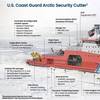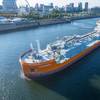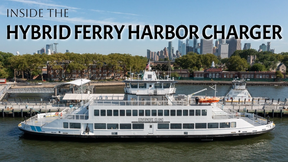Unannounced Spill Drills Exceed Expectations
The four facilities that participated in the simultaneous drills were the BP Cherry Point Refinery in Ferndale, Shore Terminal in Tacoma, Tesoro Terminal in Port Angeles and ConocoPhillips-Yellowstone Pipeline in Spokane.
Beginning around 10 a.m. on Wednesday, March 9, staff from Ecology, the U.S. Coast Guard and the federal Environmental Protection Agency arrived at the facilities and presented scenarios that called for the companies to notify appropriate officials, organize a command center, and assess what type of spill response was needed to protect the public, the environment and workers. They also had to physically deploy boom to contain the imaginary spills.
"It's important to practice using real time, real tides and real weather," said Dale Jensen, who manages Ecology's spills program. "All of them did a good job, and we were very pleased with their response."
Jensen said last week's drills were specifically designed to test the first four hours of a spill response, which are the most crucial.
"If you don't respond quickly and appropriately, the damage ends up being much worse," he said.
Each of the four facilities has unique features to address, based on the nature of nearby environmental resources to be protected. In its scenario, Tesoro deployed more than 3,000 feet of containment boom in a double-booming configuration, to contain as much of the oil as possible near the source. An additional 400 feet of boom was placed at the mouth of a newly created estuary to protect the resource from potential contamination.
Shore Terminal stores its boom on a large reel on its oil dock and is ready for rapid deployment 24 hours a day and also maintains barrier boom that is permanently deployed under the pier. During the drill, the company managed to deploy boom from the reel within 40 minutes and tie it into the barrier boom, demonstrating its ability to quickly contain an unexpected spill at the dock.
Along the pipeline that runs between Spokane and Moses Lake, ConocoPhillips staff successfully deployed boom that would protect the environmentally sensitive Crabb Creek shoreline. They had discussed this possible strategy but had not tested it until last week's drill. Booming oil on a flowing stream can be tricky and dangerous because of the hazardous conditions moving waters poses. During last week's drill, one responder was stuck in a hidden underwater mud pocket for several minutes before he was able to free himself.
The BP refinery deployed thousands of feet of boom around the dock and in front of sensitive areas. Within one hour of notification, there were more than 80 BP employees mobilized and the command post was fully operating. The company also simulated deploying oil-spill beacons that would be used to help track the spread of oil after a spill. Jensen said the beacons could be an important tactic for effective spill response.
Following the drills, maintenance records of facility-owned response equipment, such as workboats, skimmers and boom, were checked out. There was one boat failure during the drill, at the BP Refinery, but the facility had three backup boats and repairs were made immediately to get the boat back in service.
"Because large oil-storage facilities could be a terrorist target, they are a national concern," said Carl Kitz, EPA's oil-program manager. "Therefore, it's very reassuring to see the facilities demonstrate their ability to rapidly respond to a spill exercise without any forewarning."
Ecology occasionally holds unannounced drills to test the response system documented in the facilities' oil-spill contingency plans and to ensure that local employees and their response contractors know how to implement those plans.
"Most drills with these companies are scheduled in advance, so it was great to see how well they did with no notice," said Linda Pilkey-Jarvis, who coordinated the drills for Ecology. "The annual exercises pay off in terms of readiness and confidence."
State law prohibits discharging pollution into Washington's waters and requires the responsible party to report a spill and carry out response and cleanup operations.












